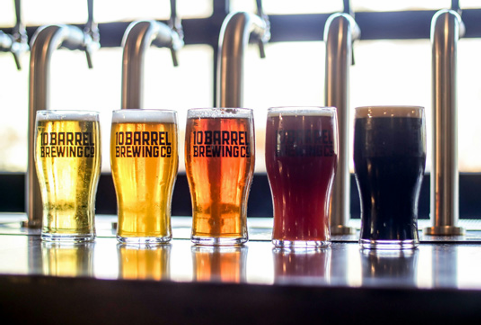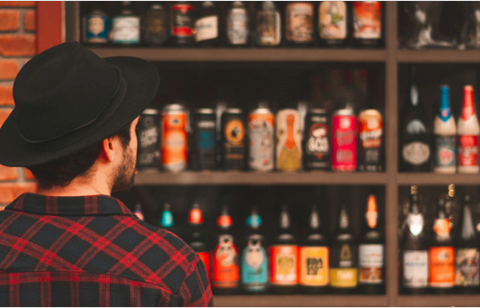
Ajay Jha
A senior Delhi-based independent journalist
India’s relationship with beer stretches back
further than most people realise. Long before the
British introduced European-style brews in the
18th century, indigenous communities across the
subcontinent were fermenting grains like rice and
millet to create beer-like beverages. These
traditional drinks, known as sura, handia, and
apong, were deeply embedded in rituals and
social customs, especially in tribal regions of the
Northeast and Central India.
The formal beer industry began in 1830 when
Edward Dyer established India’s first brewery at
Kasauli in Himachal Pradesh. It produced Lion
beer, which holds the distinction of being Asia’s
oldest beer brand. The industry expanded under
colonial influence, with breweries opening across
India.
In modern times, strong beer has emerged as the
undisputed favourite among Indian consumers.
With alcohol content typically ranging from 5 to 8
percent, it accounts for more than 85 percent of all beer sold. Strong beer offers better value
for money, delivering a stronger buzz at a lower
cost. Major breweries have capitalised on this.
Before strong beer became mainstream, some
drinkers would mix regular beer with whisky to
enhance its potency. This was a popular
workaround for those seeking a kick without
spending too much.
The Indian beer palate is changing fast. Urban
consumers, especially younger generations, are
exploring styles like lager, wheat beer, stout, ale,
and India Pale Ale.
One persistent myth is that darker beer is
stronger. In reality, colour has little to do with
alcohol content. A stout may look intense, but
could have a lower ABV than a pale lager. As
consumers become more informed, such
misconceptions are fading, paving the way for a
more nuanced appreciation of beer.
The Rise of Craft and the Changing Market
India’s beer mThe Rise of Craft and the Changing Market India’s beer market has transformed dramatically in the past decade. Once dominated by a few legacy brands, it now includes domestic giants, international players, and a growing tribe of craft arket has transformed dramatically in the past decade. Once dominated by a few legacy brands, it now includes domestic giants, international players, and a growing tribe of craft brewers. The market is valued at over ₹40,000 crore, with annual consumption crossing 300 million cases.
India’s beer mThe Rise of Craft and the Changing Market India’s beer market has transformed dramatically in the past decade. Once dominated by a few legacy brands, it now includes domestic giants, international players, and a growing tribe of craft arket has transformed dramatically in the past decade. Once dominated by a few legacy brands, it now includes domestic giants, international players, and a growing tribe of craft brewers. The market is valued at over ₹40,000 crore, with annual consumption crossing 300 million cases.
While domestic beer still holds the
lion’s share, imported beer is gaining ground.
Global brands like Budweiser, Heineken, and
Corona are now brewed locally through joint
ventures and licensing agreements. This reduces
costs and makes premium beer more accessible.
The explosion of microbreweries across the
country has added to the excitement. Several
states have relaxed licensing norms, encouraging
entrepreneurs to set up brewpubs and taprooms.
These establishments offer freshly brewed beer
with distinct flavour profiles. Young consumers
are drawn to the authenticity and variety that craft
beer provides.

Beer Beyond the Bottle
One of the most striking changes in India’s beer culture is how it has broken free from old social and seasonal constraints. Not long ago, beer was seen as a casual summer drink. Come winter, it would quietly retreat, replaced by whisky and rum. That perception is fading.
One of the most striking changes in India’s beer culture is how it has broken free from old social and seasonal constraints. Not long ago, beer was seen as a casual summer drink. Come winter, it would quietly retreat, replaced by whisky and rum. That perception is fading.
Socially, beer has become more inclusive. It is no
longer confined to college parties or roadside
bars. Professionals sip it at networking events,
couples enjoy it on date nights, and families
might share a pint at brunch. The stigma once
attached to beer drinking, especially for women,
is gradually eroding.
Beer was not always popular in India. As more
Indians started travelling, working in global
companies, or studying abroad, they were
exposed to different drinking habits.
Slowly, beer
started showing up at parties, restaurants, and
weekend hangouts. It was lighter, easier to drink and did not carry the same social baggage as
hard liquor.
The arrival of microbreweries in cities like
Bengaluru, Pune, and Gurugram saw the rise of
places that brewed their own beer. These places
offered new flavours like wheat beer, fruity ales,
and strong stouts. They became places to hang
out, listen to music, and try something new.
Women played a big role in this shift. As public
spaces became more open and inclusive, more
women started drinking socially. Beer, seen as
less intimidating than hard liquor, became a
popular choice.
A New Era Brewing
India’s beer story is no longer just about the kick. It has become craft, culture, and choice. From ancient tribal brews to modern microbreweries, the journey now reflects a broader shift in how Indians engage with taste, identity, and social experience. As consumers grow more discerning and inclusive spaces continue to flourish, beer is shedding its old stereotypes and emerging as a symbol of urban sophistication and creative expression.
India’s beer story is no longer just about the kick. It has become craft, culture, and choice. From ancient tribal brews to modern microbreweries, the journey now reflects a broader shift in how Indians engage with taste, identity, and social experience. As consumers grow more discerning and inclusive spaces continue to flourish, beer is shedding its old stereotypes and emerging as a symbol of urban sophistication and creative expression.
The road ahead is both promising and complex.
Regulatory hurdles and market pressures remain,
but so does the spirit of innovation. Whether it is
a crisp lager on a rooftop in Mumbai, a smoky
stout in a Bengaluru taproom, or a millet-based
brew reviving indigenous traditions, Indian beer
is evolving into something far richer than a
beverage.
And as more Indians raise their glasses, not just to
drink but to discover, this curious case of Indian
beer is turning into a celebration of possibility.
Cheers to that.


